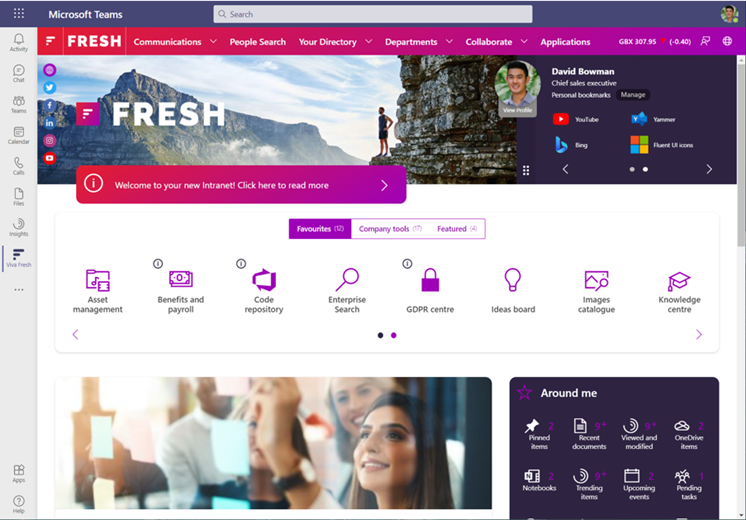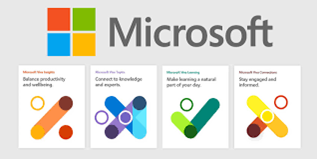The launch of Microsoft Viva earlier this year led some to speculate on whether the intranet would survive. We think it will, but the disruption caused has generated a positive dialogue around employee experience and the role the intranet plays.
The much-maligned intranet has matured from the ugly duckling, that no-one liked, to a more beautiful and elegant swan, more accepted and used by your employees than ever before, and coming in different shapes and sizes. And now, it’s even more important that your employees can collaborate and communicate effectively, and your organisation can share information easily and engage its employees positively.
So rather than asking if the intranet is still relevant, the question becomes: I’ve got all of these tools – Teams, SharePoint, Viva, Yammer – which one is the intranet?
The traditional intranet is dead…
This is bold statement but what do we have to back up the claim?
The traditional intranet was a static array of content stored, often, on a SharePoint site that was hard to access and often stale; because content owners either failed to update documents and information – or just went into set and forget mode (no judgement – it’s easy to do!).
Using the traditional intranet wasn’t a particularly pleasant or easy experience. Content was hard to find because of design and the search tools were very limited. Not surprisingly, after an initial bout of enthusiasm from the project owner, a business’ usage of the intranet would wane. This is where its unenviable reputation, as a ‘promises much but ultimately underperforms’ tool, comes from.
Various reports have looked at the amount of time wasted looking for information. A report by McKinsey found that workers can spend one fifth of their working week (that’s one day each week) just looking for internal information.
The same report also stated that when an organisation uses social media internally – i.e. instant messaging or an intranet; messages also become content. Interestingly, but not surprisingly the reports notes that, a proper search function or tool can reduce the one day a week time wasted, by as much as 35%.
That was 2012. Imagine the amount of information we have now, especially with the expanded use of tools like Teams.
One Fresh customer, Wawa, said of their former intranet “It was the classic case of an intranet being the place where content goes to die…”
Long live the intranet (a.k.a The Digital Workplace)
Clearly times have changed and they are still changing. Both employers and employees expect their intranet to be so much more than a replacement for file shares.
Just like most technologies progress can be quick but uptake can be slow without the right motivation (as highlighted by the recent pandemic). These days an intranet is still required to be a repository for documentation and content, but it must also do so much more.
It is now a basic expectation that any intranet integrates with a suite of tools, that not only enables employees to find information easily, but that puts them and their work at the centre of their working day, and also provides them with access to social media, news sites, and connect with peers and the wider business. All as an absolute minimum.
In most cases organisations now need to provide employees with a place where they can engage with the business, and each other; where they can have a voice, keep up to date with the latest company information and news, store their content, and enable others to find it and consume it. And more…
Intranets are a part of the answer, but they become far more powerful when considered alongside all the elements of an employee’s digital experience.
Sometimes, this ‘digital experience’ can feel a little like a badly planned shopping centre; nowhere to park, randomly placed stores without connecting walkways, poor signage and confused customers! They know the products and services are in there but the overall experience is confusing and annoying.
How Microsoft Viva builds on and simplifies the Intranet
Microsoft have introduced Viva as the connective fabric between all the different experiences employees are presented with these days, all hosted in an interface that most of us are now pretty familiar with – Microsoft Teams.
Viva provides that virtual walkway between an employee’s day-to-day work – on calls, in meetings and collaborating; with the organisation’s intranet or collective knowledge repository, thereby bridging the gap between work, learning, and insights.
Of course, you already need to be invested in Microsoft technologies, and ideally using SharePoint Online and Teams in some capacity, to make the most of Viva. This is because Microsoft Viva does not stand alone as an out-of-the-box product, but rather it builds on the foundations of these other applications within the Microsoft 365 suite.
One of the four pillars of Viva: Connections, is described by Microsoft as ‘your gateway to a modern employee experience’. Others simply say it’s a ‘SharePoint Intranet inside a Microsoft Teams app’.
Whichever statement you are more aligned with, simply put:
‘Viva Connections enables your employees to communicate, collaborate and find information, more easily than ever before, and all from within Microsoft Teams.’ And let’s face it, if you are using Microsoft you are using Teams – and you are using it every day.
Thanks to Viva Connections, inside Microsoft Teams, employees can enjoy a rich, personalised experience with news, content, media, conversations or discover relevant information (based on their profile) and easily find resources or complete tasks and much, much more.
And because your teams are already using Teams (we hope!), then it’s pretty easy for them to get up to speed with Viva Connections. All they need to do is click on the app in their left menu bar and wham – they’re in the intranet.

The three other pillars of Viva: Learning, Insights and Topics, all enhance this employee experience and add even more power and capability to your digital workplace and your employees’ digital experience.
If you want to know about the different types of intranet available to you, and where Microsoft Viva fits in, read our eBook.
But hang on, why not just use SharePoint and Teams?
It’s true – you can just use Teams and SharePoint. But the point is – do you really want to?
Whilst SharePoint is a very powerful platform that covers a tremendous breadth of functionality and features, it can be hugely overwhelming.

And yes, organisations can utilise the available tools to quickly build basic intranet sites (with a little pizazz if they have the time and the skill).
However, organisations taking this approach can run into challenges:
- Getting beyond the basics requires experience, expertise, a good knowledge of the architecture. A sense of humour also doesn’t hurt.
- The components and individual features have to appeal to the widest demographic possible and can lack depth – which means it’s generic and not personalised.
- It’s difficult for us to accept but not everyone is a fan of SharePoint ☹ – mainly because of bad experiences around points 1 and 2 above.
Most people agree that the user interface to SharePoint functionally is OK but it’s not the easiest tool to use.
So, your intranet is SharePoint, your employees are embedded into Teams. Viva is the window that brings the two together in a more consumable and seamless way.
But it’s still Sharepoint; it’s still pretty generic, it’s still hard to set up, structure, find and use information in, not to mention keeping everything organised and up to date.
And what if it’s just too hard and time consuming to get it looking and working the way you really want? There is another way… A fresh way.
Fresh, is a pre-packaged intranet solution, that turns your ugly duckling of a basic SharePoint intranet into a beautiful swan of a modern digital workplace. It takes the power of SharePoint and makes it easy and beautiful to use and experience.
And because it’s actually built on SharePoint, it integrates seamlessly with all your other Microsoft apps, including Viva.
Here’s a little more about what Fresh is and does.
- Adds to, extends and builds on native SharePoint functionality. Fresh fills the gaps, adds depth, in a supportive and extensible way, for customers that want to maximise their investment but need more than an ‘out of the box’ intranet.
- Reduces the barrier to entry for intranets and simplifies it. Fresh is aimed at increasing the usage that normal humans can get from SharePoint – you don’t need to be in the IT department, have a degree in engineering or have previous experience of SharePoint to use Fresh.
- Fast to deploy. Repeatable architectures and frameworks enable the quick setup of the structure, tools, sites and pages needed for a modern intranet. We’d prefer your users actually used the tools, than spend time in workshops.
- Loved by users. A user interface which is in tune with what your employees expect and that enables them to find the information they require, when they need it.
- Accessible and mobile. Following Microsoft’s lead we’ve built accessible and mobile solutions to enable the widest possible audience for the maximum possible usage.
- Secure. Because Fresh is hosted in Microsoft 365 and built within Microsoft best-practices Fresh utilises the same reliable and trusted security as SharePoint.
If you’d like to know more about how Fresh compares with other intranets and how it builds on Microsoft 365 and Viva Connections – then read our eBook.